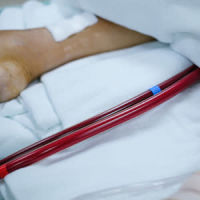ICUs in the UK have seen an 80% drop in bloodstream infections according to NIHR Guy's and St Thomas' Biomedical Research Centre-funded research. In collaboration with Guy's and St Thomas' clinicians and researchers from ICNARC (Intensive Care National Audit & Research Centre), the study analysed 1 million adult patients from 276 NHS ICUs across the UK from 2007-2012.
Published in Clinical Infectious Diseases, the study found that the number of reported ICU infections went from 7.3 every 1000 patient days in 2007, to 1.6 every 1000 patient days in 2012.
Bloodstream infections are one of the major issues facing patients in ICUs, most commonly arising from vascular or urinary catheter use, use of mechanical ventilation or as a result of surgical wounds. This spreading of the infection from the patient’s tissues into the bloodstream causes a whole-body infection which can lead to many complications, including severe sepsis.
Dr. Jonathan Edgeworth of the Guy's and St Thomas' ICU Infection Service, described his initial shock at the substantial decrease in ICU blood infections nationally. As during the time of data collection, the main focus for the NHS was on reducing MRSA and C. difficile infections. However, data from the study showed major reductions for the most common organisms to cause ICU infections, including; E. coli (57%), Candida (72%) and MRSA (95%).
Dr. Edgeworth stated that these results have shown how infection control has been successfully implemented across NHS ICUs, however, the next step should now be to reduce this even further. New targets for the NHS have now been set, in particular with the main focus on E. coli and other gram-negative bacteria. Dr. Edgeworth also identified the study as a way to help monitor any new emergences of ICU infections in the UK.
Prof. David Harrison of ICNARC also praised the success of the study, stating how the ICNARC collaboration with clinicians and data providers of the NHS has helped to provide powerful insights for the future of infection control. The study was a unique analysis of 13 years of clinical data, allowing for a comprehensive view of infection prevention across the country through engagement with NHS ICUs.
Source: NIHR Guy's and St Thomas' Biomedical Research Centre
Image Credit: iStock



























